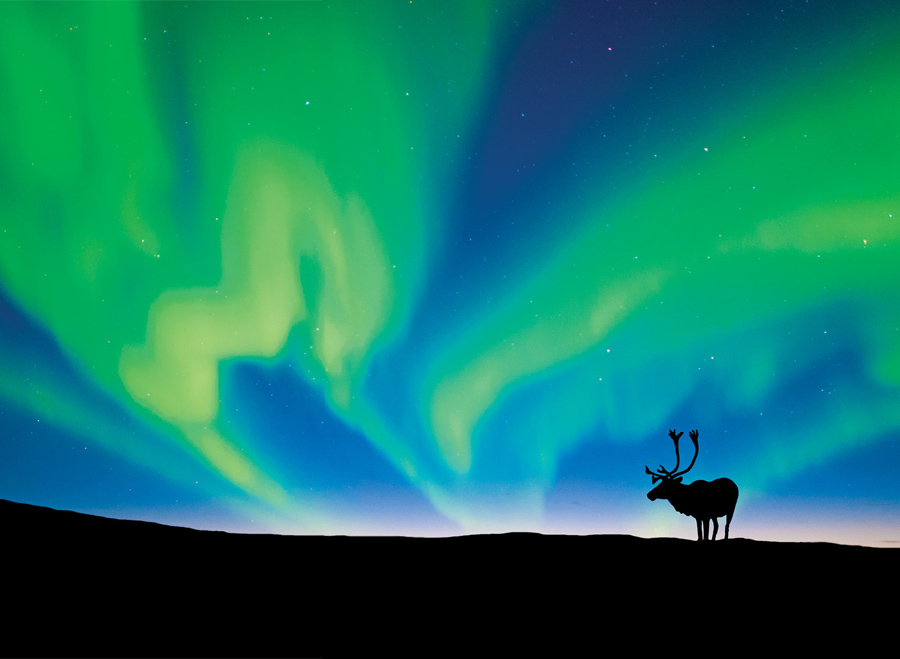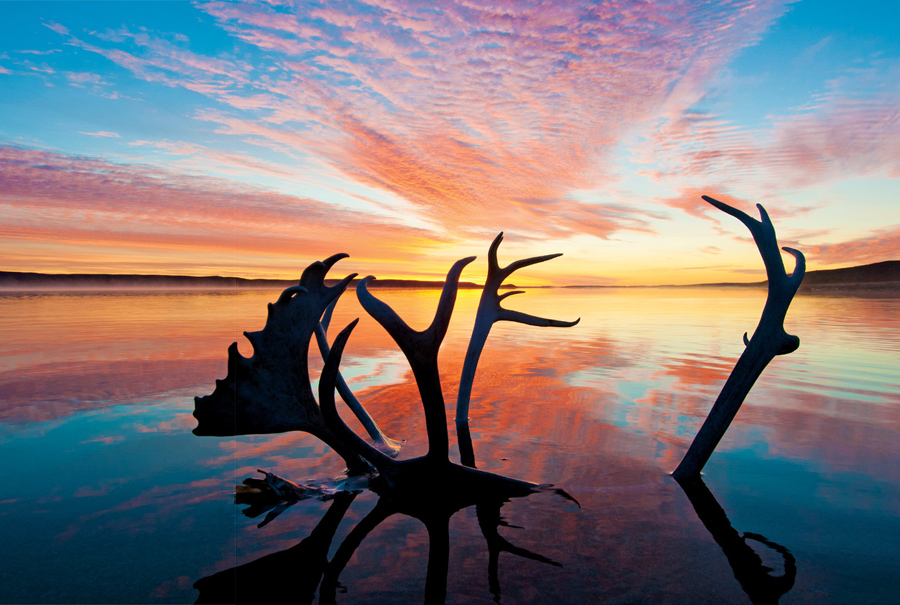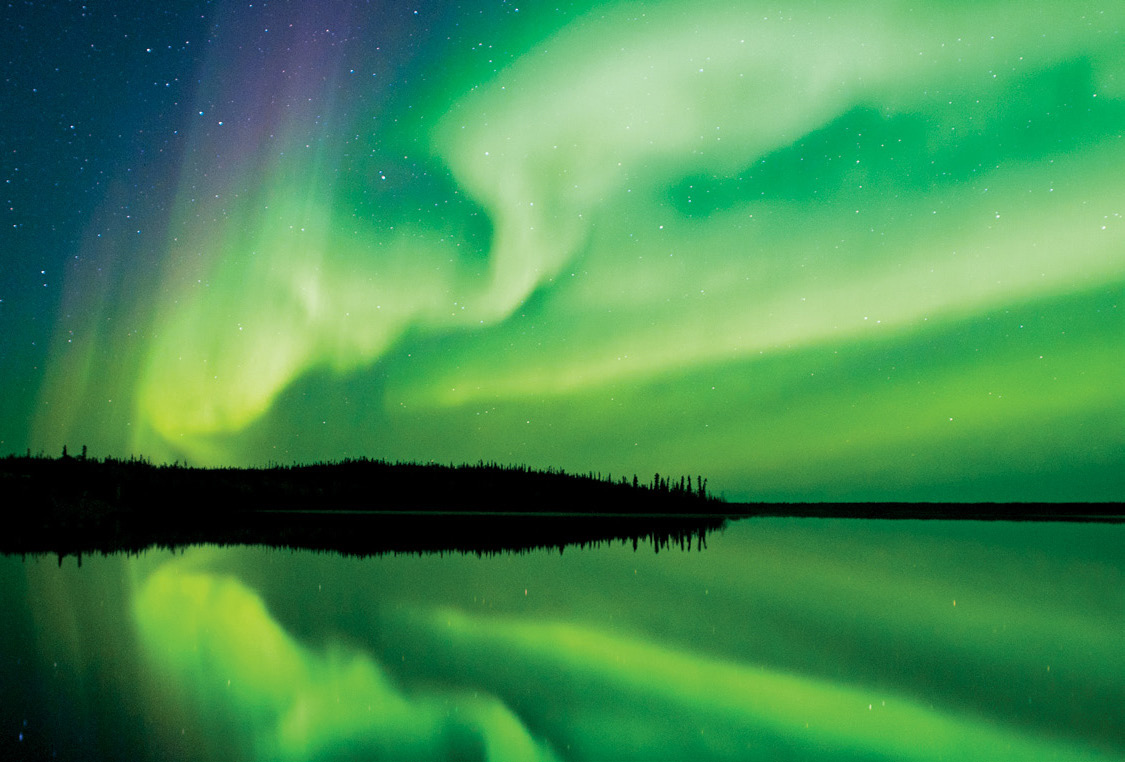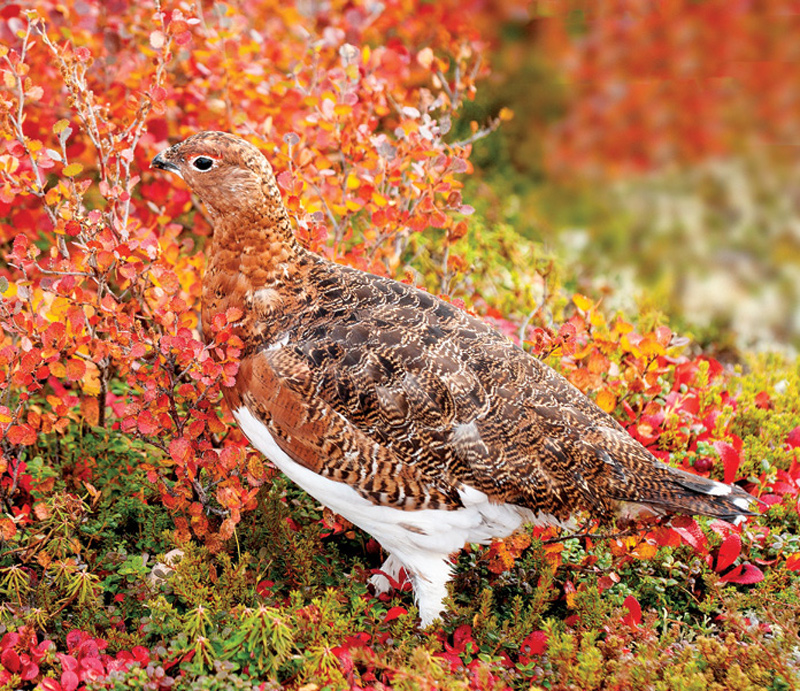I’ve been photographing nature for a very long time, beginning a decade or so before Elvis left the building. In the years since then I became a fulltime profes- sional photographer and have led nearly 200 photo trips to exotic wildlife destina- tions on every continent. Until recently, I had never been a participant on a photo tour when someone else was the leader and photography expert. Maybe it was time for me to be a student again?
With that aim in mind, in September 2011, I became one of eight eager photographers on the Arctic Photography Adventure to Peterson’s Point Lake Lodge located in the magnificent hinterlands of the Northwest Territories. The photo leader for the trip was Dr. Robert Berdan whose landscape and macro photography and Photoshop wizardry I had long admired. As well as the capable leadership and inspiring destination, the tour promised two nature subjects at the top of my personal bucket list: the northern lights and caribou migrating across the arctic tundra ablaze with autumn colour.
The tour began in Yellowknife where for several days we concentrated on boreal landscapes during the day and the aurora borealis at night. Ancient Inuit believed that the aurora borealis, or the northern lights, were the torches of spirits guiding souls to a land of happiness and plenty. First Nations peoples along the Pacific Coast thought that auroras were the cooking fires of Eskimos boiling whale blubber. My grandfather believed they were the reflection of the sun off the polar icecap. Auroras have inspired countless colourful stories and legends; their shifting cur- tains of green, red and purple light, pulsating and swirling across a blackened star-filled sky, are fuel for the imagination. Understanding the science behind the aurora doesn’t rob the display of any of its beauty and makes the spectacle even more exciting to witness.
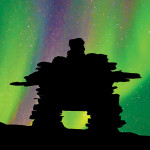
The birth of an aurora begins 150 million kilometres away, on the torrid surface of the sun. There, continuous gigantic explosions, called sunspots, send showers of charged particles – electrons and protons – hurtling into space and racing towards Earth, sometimes nearly at the speed of light. Usually it takes 30 minutes to two days for the particles to reach our planet, but Earth is not an easy target to penetrate. Surrounding Earth is a giant invisible magnetic field generated by the molten metals in the planet’s core. Most of the charged particles speeding toward us from the sun are deflected away into space by the force of the Earth’s magnetic field. Some, however, penetrate the field, and once they reach the upper layers of our atmosphere, they collide with the gases there, producing visible light. (The same thing happens in an ordinary neon sign: electrons collide with the neon gas trapped inside the light tube, and the gas emits a reddish orange light.) An aurora can take many different forms. It may be simply a diffuse glow covering the whole sky; at such times, it can be confused with thin, wispy clouds. A common auroral display is a narrow arc that can stretch across the sky for 1600 kilometres. The most beautiful auroras are those in which curtains of shimmering light fold and spiral unpredictably across the velvet blackness, constantly changing in colour, brightness and speed.
When viewed from space, an aurora forms a bright crown of light encircling the northern polar region. Yellowknife and Point Lake Lodge both lie under the magical Auroral Oval where northern lights occur on 90 percent of nights. Of course, seeing the aurora requires a cloudless sky. Auroras are most intense around the autumn and spring equinoxes, so September and March are especially good months for such a photo quest. I had seen, and salivated over, Rob Berdan’s aurora photographs in the past so I was hoping he would share his photo secrets with the group. I wasn’t disappointed. Rob happily conveyed his vast experience on the subject and worked tirelessly to make sure we all captured our own photographic memories of this remarkable celestial spectacle. Here are the great tips he shared. A sturdy tripod is a must since long exposures are a necessity to photograph the night sky. For lenses, Rob suggested that we use the fastest wide angle lens we could get our hands on. Since the aurora often stretches across the entire sky you need the coverage of a wide angle lens to capture the graceful arcs and swirls of the display. Focal lengths of 12 to 35 mm are ideal. The maximum aperture of the lens is just as important as the focal length since the aperture will ultimately determine the shutter speeds you will use.
During long shutter speeds, say 15 to 30 seconds, the stars move. During such lengthy exposures, the stars may register as streaks of light, called star trails, instead of pin-point sources of brightness. Rob’s easy formula to avoid this from happening was to divide 600 by the focal length of the lens. This calculation yields the maximum shutter speed (in seconds) that you should use if you want to avoid star trails. For example I commonly used a 24mm lens and I kept my shutter speeds shorter than 25 seconds (calculated by dividing 24 into 600). The 24mm lens I used had a maximum aperture of f1.4. By varying the ISO sensitivity of the camera’s sensor between 800 and 1600 I was able to capture even the faintest of auroras with shutter speeds below the prescribed maximum of 25 seconds. Both Canon and Nikon make a 24mm f1.4 lens and this proved to be an ideal choice for photographing the aurora.
Surprisingly, focusing the aurora is another issue. Typically, you can’t use autofocus because the aurora in a blackened night sky doesn’t provide enough contrast for the camera to detect. That’s easy to solve you say, just manually set the lens on infinity. But notice that many lenses focus a little beyond infinity and this is meant to compensate for the slight shrinkage and expansion of glass lenses as the temperature varies. So, setting the lens at infinity may yield a slightly soft photograph. Rob offered two solutions. If you own a camera with live view, position a bright star in the centre of the camera’s LCD screen, zoom to 10 power, then manually rotate the focusing ring until the star is a pin point of light without a halo around it. If your camera doesn’t have live view capability then you should take successive photographs of the same star, tweaking the focusing repeatedly and then checking the results in your LCD screen until the star is a pin point.
The second half of the Arctic Photography Adventure had us flying by twin otter over the scarlet, orange and yellow tapestry of the autumn tundra to Peterson’s Point Lake Lodge, roughly 340 kilometres north of Yellowknife. At this point I didn’t think the tour could get any better. How wrong I was. The lodge, which marvellously catered to all our creature comforts, was surrounded by rolling hills cloaked in a riot of autumn colours. During the day, migrating caribou were continually within sight and unwary ptarmigan browsed on willows next to our cabins. Some among us even saw hunting wolves and an elusive wolverine. At night, the northern lights took centre stage again, bedazzling us with their lavish variability. Each day at Point Lake drifted into the next in a continual banquet of spectacular arctic imagery. Now, three months later, it’s hard to recall a moment when I wasn’t giddy with excitement at what I was seeing and experiencing.
As I previously mentioned, auroras form as a result of sunspot activity. This activity fluctuates and follows an approximate 11-year cycle. During periods of high sunspot activity, the northern lights are bigger and brighter and may occur farther south than usual. In 1958, for example, the northern lights were visible as far south as Mexico. Astronomers predict that the next sunspot peak, called a solar maximum, will occur in 2013 and will match the intensity of the spectacular displays of 1958. If what I experienced in 2011 is any indication of how breathtaking the auroras will be a year from now then this will is an event that no nature photographer should miss.
Follow Wayne’s adventures at his website – www.waynelynch.ca. Dr. Rob Berdan is planning future auroral adventures to Petersons Point Lake Lodge in 2012 and 2013. For details check his web site – www.canadiannaturephotographer.com



